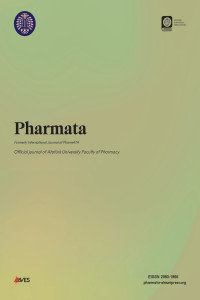Development and In Vitro Characterization of Nanoemulsion Containing Hippophaes Rhamnoides Aqueous Extract
Development and In Vitro Characterization of Nanoemulsion Containing Hippophaes Rhamnoides Aqueous Extract
Aim: Hippophaes rhamnoides is a member of the Elaeagnaceae family and grows in many countries of world such as Turkey, France, Germany, Norway and Russia. Hippophaes rhamnoides extracts has antioxidant, anticancer, antidiabetic, antiviral and cardiovascular protective effect. Nanoemulsions (NEs) are suitable systems for formulations of herbal extracts. The aim of this study is to develop and in vitro characterize NE formulation containing Hippophaes rhamnoides aqueous extract (AE-Hr) .
Material and Method: AE-Hr-containing (AE-Hr-NE) or blank (B-NE) NE formulations were prepared using ethyl oleate, Lipoid S100, Kollphor RH40, Pluronic F68, DMSO, and ultrapure water. The droplet size, PDI and zeta potential values of NEs were determined and pH measurement, FT-IR and rheological analyzes were also performed.
Results: The droplet size and PDI values of NEs were found < 200 nm and < 0.3, which indicates monodispersity. Also the zeta potential values of B-NE and AE-Hr-NE were determined as (-)28.51±2.61 and (-)30.11±2.02 mV, respectively. FT-IR results showed that the extract is completely dissolved in the oil phase of formulations.
Conclusion: The NE formulation containing AE-Hr was successfully prepared and characterized. The formulation may be beneficial for usage of Hippophaes rhamnoides aqueous extract.
Keywords:
Hippophaes rhamnoides, in vitro characterization, nanoemulsion,
___
- 1. Sneha K, Kumar A. Nanoemulsions: techniques for the preparation and the recent advances in their food applications. Innov Food Sci Emerg Technol. 2022;76:102914.
- 2. Lovelyn C, Attama AA. Current state of nanoemulsions in drug delivery. J Biomater Nanobiotechnol. 2011;02(5):626-639.
- 3. Singh Y, Meher JG, Raval K, et al. Nanoemulsion: concepts, development and applications in drug delivery. J Control Release. 2017; 252:28-49.
- 4. Hallaj-Nezhadi S, Hassan M. Nanoliposome-based antibacterial drug delivery. Drug Deliv. 2015;22(5):581-589.
- 5. Yukuyama MN, Kato ET, Lobenberg R, Bou-Chacra NA. Challenges and future prospects of nanoemulsion as a drug delivery system. Curr Pharm Des. 2017;23(3):495-508.
- 6. Suryakumar G, Gupta A. Medicinal and therapeutic potential of Sea buckthorn (Hippophae rhamnoides L.). J Ethnopharmacol. 2011; 138(2):268-278.
- 7. Jaśniewska A, Diowksz A. Wide spectrum of active compounds in sea buckthorn (Hippophae rhamnoides) for disease prevention and food production. Antioxidants (Basel). 2021;10(8):1-17.
- 8. Wang NN, Zheng WH, Zhang KX, Wen XF, Lu SG, Yang ZG. Research progress on chemical constituents and pharmacological activities of seabuckthorn and prediction of its Q-markers. Zhongguo Zhong Yao Za Zhi. 2021;46(21):5522-5532.
- 9. Ji M, Gong X, Li X, Wang C, Li M. Advanced Research on the Antioxidant Activity and Mechanism of polyphenols from Hippophae species — A review. Molecules. 2020;25(4):1-24.
- 10. Olas B. Sea buckthorn as a source of important bioactive compounds in cardiovascular diseases. Food Chem Toxicol. 2016;97:199-204.
- 11. Singh IP, Ahmad F, Gore DD, et al. Therapeutic potential of seabuckthorn: a patent review (2000-2018). Expert Opin Ther Pat. 2019; 29(9):733-744.
- 12. Bahramsoltani R, Farzaei MH, Rahimi R. Medicinal plants and their natural components as future drugs for the treatment of burn wounds : an integrative review. Arch Dermatol Res. 2014;306(7):601- 617.
- 13. Pundir S, Garg P, Dviwedi A, et al. Ethnomedicinal uses, phytochemistry and dermatological effects of Hippophae rhamnoides L.: A review. J Ethnopharmacol. 2021;266:113434.
- 14. Bjørklund G, Dadar M, Martins N, et al. Brief challenges on medicinal plants: an eye-opening look at ageing-related disorders. Basic Clin Pharmacol Toxicol. 2018;122(6):539-558.
- 15. Gajendıran A, Abraham J. Nanoemulsions for drug delivery. In: Keservani RK, Sharma AK, eds. Apple Academic Press. Nanodispersions for Drug Delivery; 2019:1-45.
- 16. Rızvanullah M, Ahmad MZ, Ahmad J, Algahtan MSN. Nanoemulsions: formulation insights, applications, and recent advances. Keservani RK & Sharma AK, eds. Nanodispersions for Drug Delivery. 1st edn. Apple Academic Press; 2018.
- 17. Ku S, Goh Bh, Lee LH. Khan TM. Nanoemulsıons: routes of administration and applications. In: In Keservani RK & Sharma AK eds. Nanodispersions for Drug Delivery. 1st edn. Apple Academic Press; 2018.
- 18. Zeng L, Liu Y, Pan J, Liu X. Formulation and evaluation of norcanthridin nanoemulsions against the plutella xylostella (Lepidotera: Plutellidae). BMC Biotechnol. 2019;19(1):1-11.
- 19. Danaei M, Dehghankhold M, Ataei S, et al. Impact of particle size and polydispersity index on the clinical applications of lipidic nanocarrier systems. Pharmaceutics. 2018;10(2):1-17.
- 20. Dhawan B, Aggarwal G, Harikumar SL. Enhanced transdermal permeability of piroxicam through novel nanoemulgel formulation. Int J Pharm Investig. 2014;4(2):65-76.
- 21. Wang L, Dong J, Chen J, Eastoe J, Li X. Design and optimization of a new self-nanoemulsifying drug delivery system. J Colloid Interface Sci. 2009;330(2):443-448.
- 22. Oliveira A, Duarte JL, Cruz RAS, Conceição EC, Carvalho JCT, Fernandes CP. Utilization of dynamic light scattering to evaluate Pterodon emarginatus oleoresin-based nanoemulsion formation by non-heating and solvent-free method. Brazillian J Pharmacogn. 2017;27(3):401-406.
- 23. Arianto A, Cindy C. Preparation and evaluation of sunflower oil nanoemulsion as a sunscreen. Open Access Maced J Med Sci. 2019;7(22):3757-3761.
- 24. Ugur Kaplan AB, Cetin M, Orgul D, Taghizadehghalehjoughi A, Hacımuftuoglu A, Hekimoglu S. Formulation and in vitro evaluation of topical nanoemulsion and nanoemulsion-based gels containing daidzein. J Drug Deliv Sci Technol. 2019;52:189-203.
- Başlangıç: 2021
- Yayıncı: Atatürk Üniversitesi
Sayıdaki Diğer Makaleler
IN VITRO CYTOTOXICITY TEST METHODS: MTT and NRU
Fatih BAYGUTALP, Nurcan KILIÇ BAYGUTALP, Faruk URAK, Abdulbaki BİLGİC
Süleyman ÇETİN, Yaşar Furkan KILINBOZ, Afife Büşra UĞUR KAPLAN, Meltem ÇETİN
Evaluation Excipients and pH Effects on Impurity of Desloratadine Syrup Formulation
